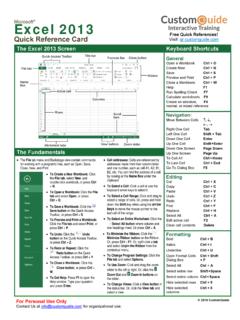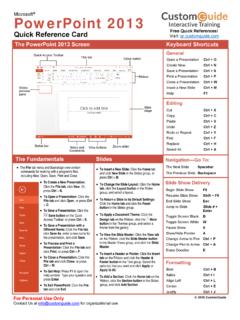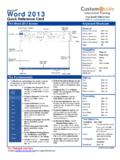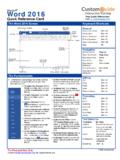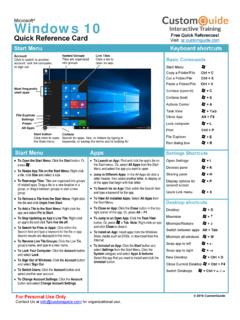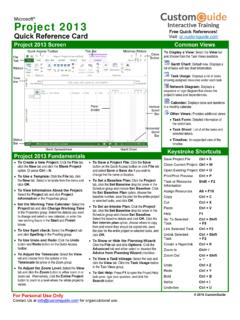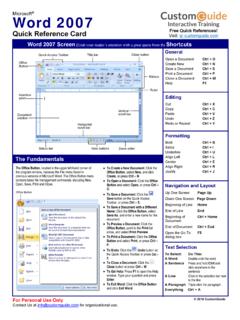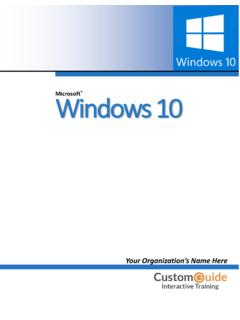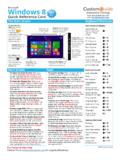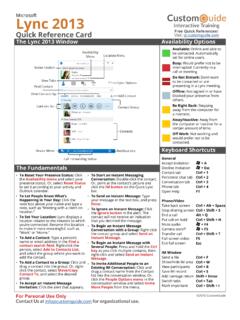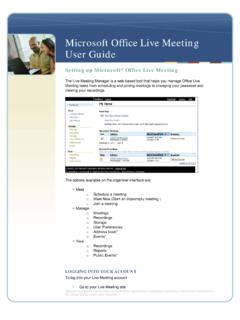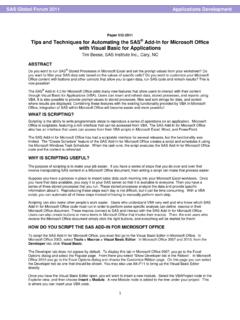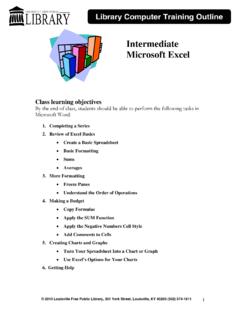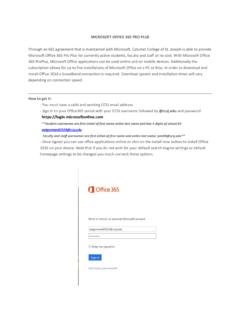Transcription of Microsoft PowerPoint 2010 - Microsoft Office Training
1 Microsoft PowerPoint 2010 Quick Reference Card PowerPoint 2010 Screen Keyboard Shortcuts The Fundamentals To Create a New Presentation: click the File tab, click New, and clickCreate. Or, press Ctrl + N. To Open a Presentation: click theFile tab and click Open, or press Ctrl+ O. To Save a Presentation: click the Save button on the Quick Access Toolbar, or press Ctrl + S. To Save a Presentation with aDifferent Name: click the File tab, click Save As, enter a new name forthe presentation, and click Save. To Preview and Print aPresentation: click the File tab andclick Print, or press Ctrl + P. To Close a Presentation: click theFile tab and click Close, or press Ctrl+ W. To Get Help: Press F1 to open theHelp window. Type your question andpress Enter. To Exit PowerPoint : click the Filetab and click a Presentation Ctrl + O Create New Ctrl + N Save a Presentation Ctrl + S Print a Presentation Ctrl + P Close a Presentation Ctrl + W Insert a New Slide Ctrl + M Help F1 General Editing Formatting Bold Ctrl + B Italics Ctrl + I Align Left Ctrl + L Center Ctrl + E Justify Ctrl + J Cut Ctrl + X Copy Ctrl + C Paste Ctrl + V Undo Ctrl + Z Redo or Repeat Ctrl + Y FindCtrl + F ReplaceCtrl + H Select AllCtrl + A Navigation Go To.
2 The Next Slide Spacebar The Previous Slide Backspace Slide Show Delivery Begin Slide Show F5 Resume Slide Show Shift + F5 End Slide Show Esc Jump to Slide Slide # + Enter Toggle Screen Black B Toggle Screen White W Pause Show S Show/Hide Pointer A Change Arrow to Pen Ctrl + P Change Pen to Arrow Ctrl + A Erase Doodles E The File tab menu and Backstage view containcommands for working with a program s files,including New, Open, Save, Print and Access Toolbar Title bar Slide pane Zoom slider RibbonView buttonsClose buttonSlides tab Status bar Outline tab Notes pane To Insert a New Slide: click the Home taband click New Slide in the Slides group, orpress Ctrl + M. To Change the Slide Layout: click the Hometab, click the Layout button in the Slidesgroup, and select a layout. To Return a Slide to its Default Settings: click the Home tab and click the Reset buttonin the Slides group. To Apply a Document Theme: click theDesign tab on the Ribbon, click the Morebutton in the Themes group, and select atheme from the gallery.
3 To Change the Slide Background: click theDesign tab on the Ribbon, click theBackground Styles button in the Backgroundgroup, and select a background. To View the Slide Master: click the View tabon the Ribbon, click the Slide Master button inthe Master Views group, and click the SlideMaster or the appropriate Layout Master inthe Outline pane. To Insert a Header or Footer: click the Inserttab on the Ribbon and click the Header &Footer button in the Text group. Select theoption(s) that you want and click Apply orApply to All. To Add a Section: click the Home tab on theRibbon, click the Section button in the Slidesgroup, and click Add Section. Slides 2016 CustomGuide For Personal Use Only Contact Us at for organizational Quick References!Visit: X Formatting Images, Multimedia, and ObjectsViews To Cut or Copy Text: Select the text you want to cut or copy and click theCut or Copy button in the Clipboard group on the Home tab. To Paste Text: Place the insertion point where you want to paste and clickthe Paste button in the Clipboard group on the Home tab.
4 To Format Selected Text: Use the commands in the Font group on theHome tab, or click the Dialog Box Launcher in the Font group to open theFont dialog box. To Copy Formatting with the Format Painter: Select the text with theformatting you want to copy and click the Format Painter button in theClipboard group on the Home tab. Then, select the text you want to apply thecopied formatting to. To Change Paragraph Alignment: Select the paragraph(s) and click theappropriate alignment button (Align Left, Center, Align Right,or Justify) in the Paragraph group on the Home tab. To Create a Bulleted or Numbered List: Select the paragraphs you want tobullet or number and click the Bullets or Numbering button in theParagraph group on the Home tab. To Change Paragraph Line Spacing: Select the paragraph(s), click the Line Spacing button in the Paragraph group on the Home tab, and select an option from the list. To Correct a Spelling Error: Right- click the error and select a correctionfrom the contextual menu.
5 Or, press F7 to run the Spell Checker. To Add a Slide Transition: Navigate to the slide you want to add a transitionto. click the Transitions tab on the Ribbon, click the More button in theTransition to This Slide group, and select a transition effect. To Add an Animation Effect to an Object: Select the object that you want toanimate, click the Animations tab on the Ribbon. click the More button inthe Animation group, and select an animation effect. To Copy Animation Effects from One Object to Another: Select the objectwith the animation effect you want to copy, click the Animations tab on theRibbon, and click the Animation Painter button in the Advanced Animationgroup. Then, click the object you want to apply the copied animation effect to. To Insert a Picture: click the Insert tab on the Ribbon and click the Picturebutton in the Images group. Find the picture you want to insert and clickInsert. To Insert a Clip Art Graphic: click the Insert tab on the Ribbon and click theClip Art button in the Images group.
6 Type the name of what you re looking forin the Search for box and click Go. To Insert a Video file: click the Insert tab on the Ribbon and click the Videobutton in the Media group. Find the video you want to insert and click Insert. To Insert a Video from the Web: click the Insert tab on the Ribbon, click theVideo button list arrow in the Media group, and select Video from Web the video s Embed code into the Insert Video from Web Site dialog boxand click Insert. To Insert an Audio clip: click the Insert tab on the Ribbon, click the Audiobutton list arrow in the Media group, and select Audio from File. Find theaudio clip that you want to insert and click Insert. To Draw a Shape: click the Insert tab on the Ribbon, click the Shapesbutton in the Illustrations group, and select the shape you want to , click where you want to draw the shape and drag until the shapereaches the desired size. Hold down the Shift key while you drag to draw aperfectly proportioned shape or straight line.
7 To Insert SmartArt: click the Insert tab on the Ribbon and click theSmartArt button in the Illustrations group. Select the SmartArt you want toinsert and click OK. To Format an Object: Double- click the object and use the commands locatedon the Format tab. To Move an Object: click the object and drag it to a new location. Releasethe mouse button when you re finished. To Resize an Object: click the object to select it, click and drag one of itssizing handles ( ), and release the mouse button when the object reachesthe desired size. Hold down the Shift key while dragging to maintain theobject s proportions while resizing it. To Delete an Object: Select the object and press the Delete Outline Pane The Outline tab focuses on the content of the presentation. Use this tab when you want to adjust the textual structure or add large amounts of text. The Slides tab contains a thumbnail image of every slide in the presentation; click a thumbnail to jump to that slide. You can also rearrange, add, or delete slides here.
8 Transitions and Animation Effects Normal view: This is the default view in PowerPoint 2010 . Normal view includes the Outline pane, Slide pane, and Notes pane. Slide Sorter view: Displays all the slides in the presentation as thumbnails (tiny images). Use Slide Sorter view when you want to rearrange the order of slides or add transition effects between slides. Reading View: Similar to Slide Show view, it displays the presentation in a window with simple controls, making it easy to review. Slide Show view: Displays the presentation as an electronic slide show. Whenever you deliver a presentation in front of an audience, Slide Show view is definitely the view you want to use. Slide Show Delivery To Present a Slide Show: click the Slide Show button on the status bar, orpress F5. To Use the Laser Pointer: In Slide Show view, press and hold down the Ctrlkey while clicking and holding the left mouse button . To Use the Pen: In Slide Show view, press Ctrl + P and then draw on thescreen.
9 Press Ctrl + A to switch back to the arrow pointer. Press E to eraseyour doodles. To Advance to the Next Slide: Press Spacebar. Or, click the left mousebutton. To Go Back to the Previous Slide: Press Backspace or Page Up. To Add Slide Timings: click the Slide Show tab on the Ribbon and click theRehearse Timings button in the Set Up group. Navigate through thepresentation, pausing on each slide for the amount of time you wish to display itduring your show. click Yes to save your timings. To End a Slide Show: Press Esc. 2016 CustomGuide For Personal Use Only Contact Us at for organizational Training for Over 2,000 Topics: Office 2016 for Windows Excel 2016 Outlook 2016 PowerPoint 2016 Word 2016 Office 2016 for Mac Excel 2016 Outlook 2016 PowerPoint 2016 Word 2016 Office 365 OneDrive for Business Skype for Business Office 2013 Excel 2013 OneNote 2013 Outlook 2013 PowerPoint 2013 SharePoint 2013 Word 2013 Operating Systems Windows 10 Windows 8 Windows 7 Computer Basics Mac OS Also Available Soft Skills Courses Spanish Editions Each Course Includes: Interactive Tutorials Get hands on Training with bite sized tutorials that recreate the experience of using actual software.
10 SCORM compatible for your LMS! View Sample Customizable Courseware Why write Training materials when we ve done it for you? Training manuals, practice files, and instructor guides with unlimited printing rights! View SampleInteractive Assessments How much do your users really know? Accurately measure skills with realistic software simulations. SCORM compatible for your LMS! View Sample Quick References Handy cheat sheets with shortcuts, tips, and tricks. Free for personal use! View Samples Over 3,000 Companies Rely on CustomGuide We hope you enjoy this free quick reference! Please review our other Training products; see the samples below. Please Contact us for a Free Trial! |
